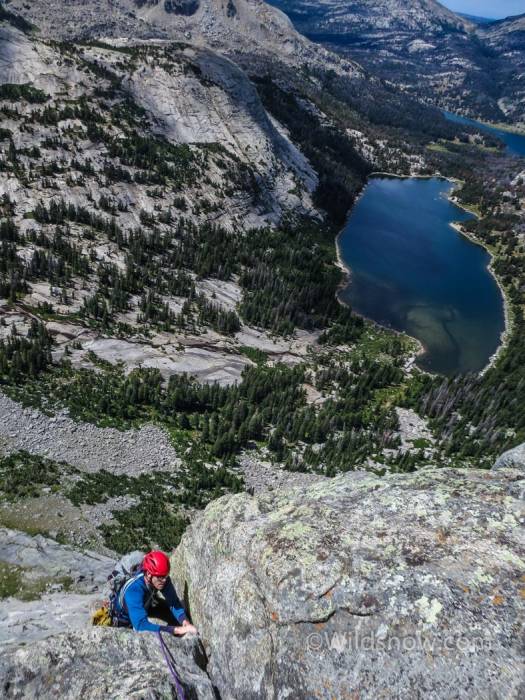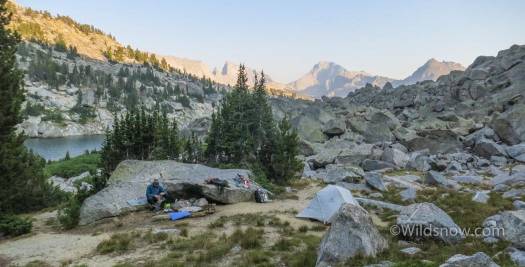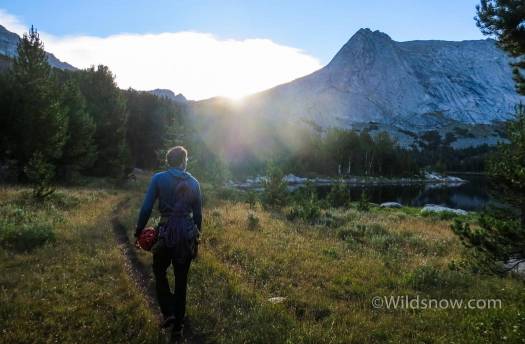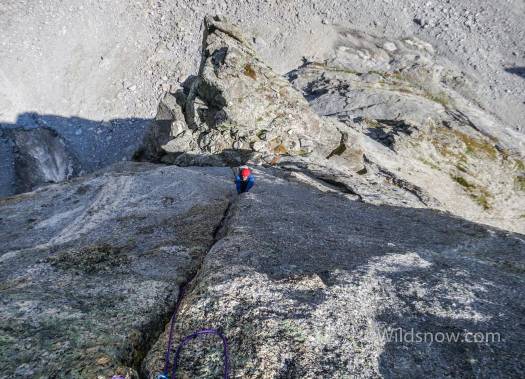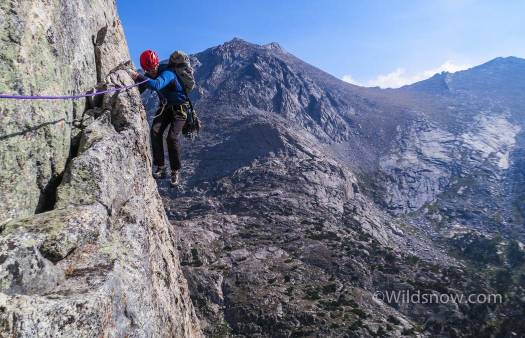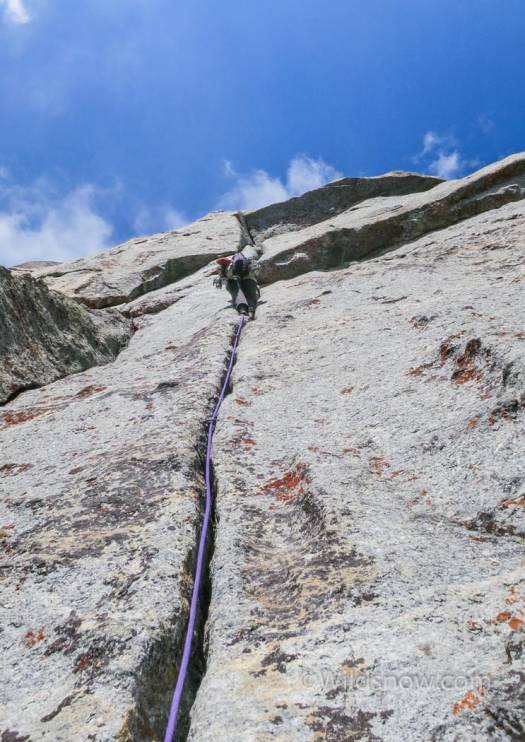The Wind River mountains of Wyoming hold a special place in my heart. Dad introduced me to them on several incredible backpacking trips as a young boy. When I was 16, I traversed the northern part of the range on a 30-day NOLS mountaineering course. In the Winds I walked on my first glaciers, placed my first trad gear, and climbed my first alpine rock. With a wonderful lack of people, the beautiful remote peaks of the Winds are one of a kind.
School and other summer plans got in the way, and I haven’t been back to the range since the end of high school. In the intervening years I’ve changed, but my love for the mountains hasn’t. I’ve become much more interested in rock climbing, especially in the alpine. The past few years I’ve felt the pull of the Winds. The time had come to head back into the Wyoming peaks, this time with granite cracks on my mind.
My college friend Zack had some time off in mid-August; perfect timing for a Wind River trip. He’d been climbing in the Winds once before and was psyched to head up again. In the early hours of Wednesday I met Zack at the Silt McDonalds, and we started our Journey. The drive was just as desolate as I remembered. We passed through a handful of tiny towns, and I didn’t have cell service once for the last 5 hours of the drive.
We arrived at Big Sandy trailhead and found a spot among the 100+ other cars. I’ve heard that over half of the visitors to the Wind River mountains come in through this trailhead. I believe it. However, after hiking up the trail a bit, I began to experience the solitude of the mountains. We camped in a secluded spot above Big Sandy Lake, a short walk away from our objective for the next morning; Haystack Mountain.
It rained overnight, but after waking up and making breakfast, the skies turned blue. Elated, we headed up the trail towards Clear Lake, located beneath Haystack. In my preparations for the trip, I had asked around Carbondale for a guidebook to the Winds, with no success. Instead, we loaded Mountain Project on our phones, and printed out some additional info. With route-finding often the crux on alpine rock, I hoped it would be enough.
For our intended route, the 5.9 Minor Dihedral, our beta was a bit thin, but we decided to go for it. We successfully found the base of the route, and assumed it followed a discontinuous crack system that ended at the obvious dihedral. Later, we learned that you need to traverse horizontally directly at the start to reach a different crack system. Instead, I followed a slabby flake until it petered out. Zach took the next pitch, and sent a proud lead up a sparsely protected 10+ friction slab. I let out a sigh of relief when he finally reached another crack, and followed on top-rope. I climbed the crack above (which also felt harder than 5.9) that lead to the base of the real route. We followed the eponymous dihedral, and enjoyed stellar climbing.
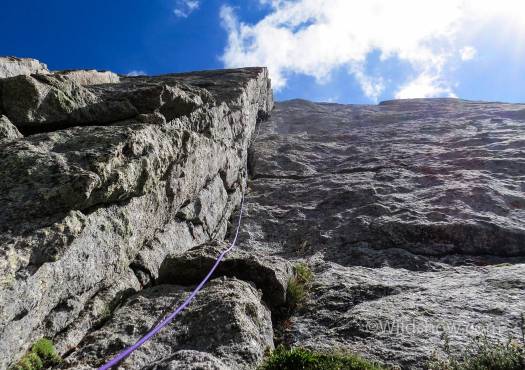
Once we got on-route, the Minor Dihedral had some great climbing. Here’s Zack heading up the start of the Dihedral.
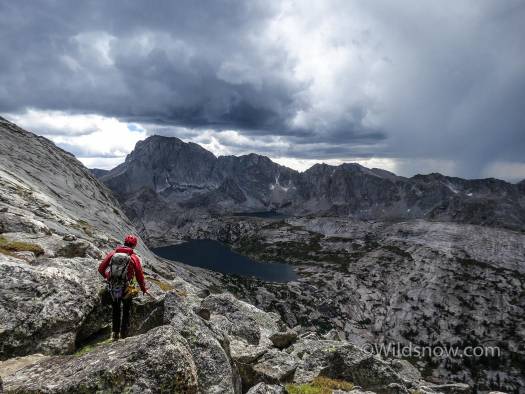
Descending Haystack just as a thunderstorm approaches. Other than the brief storm, we had incredible weather the entire trip.
That night we moved camp up to Jackass Pass, centrally located for climbing with breathtaking views. For our second climb we decided on the northeast face of Warrior 1, an “adventurous” Fred Beckey route. The next morning, as we approached the base of the route, I found that the paper beta had slipped out of my pocket. We still both had our smartphones, however those aren’t as reliable as good dry wood pulp. Still recovering from our experience the previous day, we were careful to find the base of the route. We started off in the right spot, and enjoyed great climbing as we ascended. The climb swung out onto the northeast ridge, with awesome exposure above the talus and glacier below. I snagged the lead on two of the better pitches, including an awesome 5.9 hand crack near the top of the peak. We reached the summit in good time, and began to consider our descent options. Although we knew that the route required a 70 meter rope to rappel, we only brought a 60. I had heard vague descriptions of some other descent options, but after a brief investigation none seemed to appear. We decided to go for the rappels. We utilized our cordalettes to extend the rope with a biner-block, and were able to make our way down On our second to last rappel we left a nut to make it to the next station. Later I read of others using a single 70 meter that needed to make their own anchor at that pitch as well. We made it down with no further incidents. Looking back, using the 60 worked, but we were lucky. In the future i don’t think i’ll try to make 70 meter rappels with a 60. That might sound like common sense, but I guess we had to learn that one the hard way.
The next day we both felt the previous two days of climbing and hiking, so we decided to take it easy. In the morning we moved our camp a mile or so down the pass next to a lake The rest of the day was spent reading, lounging, and fishing. The fishing in the winds is incredible. The fish certainly aren’t trophies, but for a casual fly-fisher like myself, quantity outweighs quality. After only a few hours of fishing, Zack and I both caught a few fish, ranging from tiny sardines to a barely respectable 11 inches.
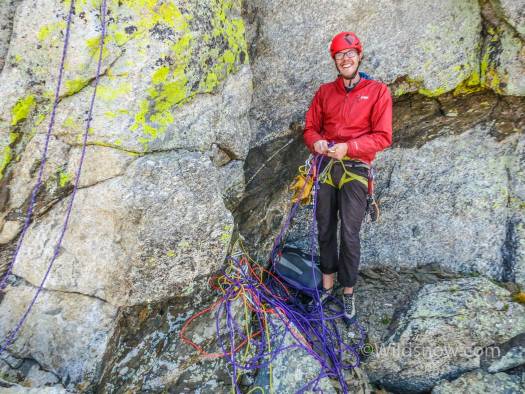
We were pretty excited to have got down this 70 meter rappel with our 60 meter rope. That pile of stuff is all the cords we tied to the rope to extend it. Adventure.
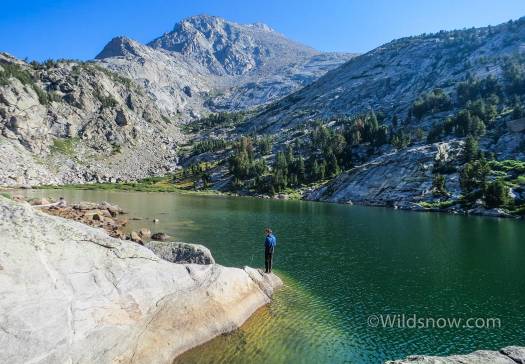
Zack testing out the flyfishing in the lake next to our camp. We took a rest day and caught a few fish.
After our day of rest, we decided to go for our ultimate goal of the trip: Black Elk. A stout line up the face of Warbonnet Peak right above our camp, with a pitch of 5.11 offwidth/fist crack. Back in the day the climb used to be the hardest in the Cirque. I felt intimidated, but excited to give it a go. We woke early, and made our way to the base of the route. After a bit of wandery scrambling, we started climbing. After a pitch of face climbing, we saw that the route follows a crack system all the way to the summit. Zack and I swapped leads until the crux pitch. I strategically took the pitch below, a stellar 5.10 hand crack, I topped out on the pitch a bit worked. Without hesitation Zack fired the splitter crux crack. The pitch was steep, but accepted hands and fists for the most part. When it started to get wide, fist jams were still present, although a bit more tenuous. When it finally got too wide for that, I pulled on a #4 for a move, and was able to make it to some more jams. Whew! The pitch was strenuous, and tired me out. Zack agreed to lead the next few pitches. The rest of the climb was excellent, with everything from hand to finger cracks, and a few tenuous face moves.
We walked off the back of Warbonnet, and passed out back at camp. The next morning we woke late, did a bit of lounging and fishing, then headed down the trail. After a few hours of hiking we made it back to the packed parking lot.
It was awesome to see the Winds again after such a long time away, especially through the new lens of climbing. We hit it perfectly, with mild temps, no bugs, and nearly perfect weather. We climbed a smattering of classics, but didn’t actually even climb in the Cirque. I’d love to come back and do a few more climbs, including some of the easy mega classics. This’ll have to become a yearly trip.
Louie Dawson earned his Bachelor Degree in Industrial Design from Western Washington University in 2014. When he’s not skiing Mount Baker or somewhere equally as snowy, he’s thinking about new products to make ski mountaineering more fun and safe.

